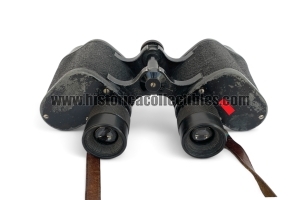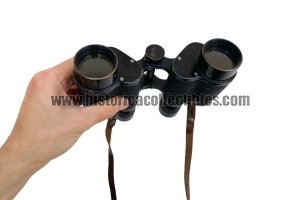Doppelfernrohr Voigtländer 8x36, Kaiserliche Marine, circa 1917
Doppelfernrohr 8x36, produced by Voigtländer, Braunschweig (Vienna) for the Kaiserliche Marine (Imperial German Navy) in around 1915, as can be seen from the marks impressed on the eyeplates, which show "Voigtländer Braunschweig" and serial number XXXXX on the left, while on the right the Imperial German Crown with the M for Marine underneath and the assignment number XXXX. Next to it we find the Lion, symbol of the city of Braunschweig and the 8x36 enlargements. Between the two objective lenses, a knurled wheel tightens the chosen interpupillary distance.
It is really very interesting to come across the binoculars produced in that period by Voigtländer, there were many models produced but different from each other, despite the same optical characteristics such as magnification and lens diameter. Solid binoculars, really well built but with characteristics, albeit "small", very different and incisive on the visual and aesthetic performance. They were highly appreciated binoculars by the senior officers of the Kaiserliche Marine, given the very high construction qualities.
The binoculars come complete with their original shoulder strap.
The vision is perfectly sharp, clear and collimated and all mechanisms work precisely.
Voigtländer Braunschweig was created in Vienna in 1756, the company took its name from its founder, Johann Christoph Voigtländer and initially produced optical instruments, intended in particular for microscopes and other scientific equipment. Among the first creations were the Petzval type lenses, and others destined to become famous, such as the Collinear and the Heliar.
In 1840 he built the first lens for cameras, while in 1841 the first entirely metal daguerreotype was developed. He subsequently produced plate machines, built in a practically artisanal way.
In 1849 the headquarters were moved to Braunschweig, Germany, where Voigtländer & Sohn was born shortly thereafter.
In 1925 it was purchased by Schering AG. Voigtländer later oriented its production towards photographic devices accessible to all, and this allowed it to remain among the market leaders until after the Second World War.
In 1958 it was bought by the Carl Zeiss Foundation and in 1972 it was renamed "Zeiss Ikon Voigtländer".
In 1973 the brand became the property of Rollei until the crisis of 1982.
At this point the brand was bought first by "Plus foto", which from 1980 marketed Voigtländer cameras produced by Ricoh and Chinon and then in 1995 by "Ringfoto", but this represents more than anything else a long period of darkness. Finally in 1999 the brand was reborn with the purchase by the Japanese Cosina.
In 1840 he built the first lens for cameras, while in 1841 the first entirely metal daguerreotype was developed. He subsequently produced plate machines, built in a practically artisanal way.
In 1849 the headquarters were moved to Braunschweig, Germany, where Voigtländer & Sohn was born shortly thereafter.
In 1925 it was purchased by Schering AG. Voigtländer later oriented its production towards photographic devices accessible to all, and this allowed it to remain among the market leaders until after the Second World War.
In 1958 it was bought by the Carl Zeiss Foundation and in 1972 it was renamed "Zeiss Ikon Voigtländer".
In 1973 the brand became the property of Rollei until the crisis of 1982.
At this point the brand was bought first by "Plus foto", which from 1980 marketed Voigtländer cameras produced by Ricoh and Chinon and then in 1995 by "Ringfoto", but this represents more than anything else a long period of darkness. Finally in 1999 the brand was reborn with the purchase by the Japanese Cosina.


